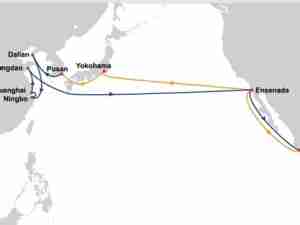Danish shipping and oil group A.P. Moller-Maersk rebounded into profit in the first half, benefiting from a recovery in freight rates and volumes to pre-crisis levels, and lifted its 2010 outlook.
Dubai's government-controlled DP World, one of the world's largest port operators, reported growing container volumes and better pricing, taking its profit past analysts' expectations.
Figures from the two groups support evidence of rising world trade flows -- Maersk in particular is seen as a barometer of global trade as its fleet has 14.6 percent of all container shipping capacity.
The Suez Canal said recently it had seen its highest daily revenue since the 2008 financial crisis, while Germany's TUI AG said it saw a rebound in demand at its Hapag-Lloyd container shipping unit.
A.P. Moller-Maersk CEO Nils Smedegaard Andersen said container rates were back at 2008 levels and volumes were close to that mark as analysts heralded a surge in global restocking.
"Overall expectations for the A.P. Moller-Maersk Group are that the result for 2010 will exceed $4 billion," the group said, upgrading its outlook made last month that the result would exceed the 2008 level of $3.5 billion.
Andersen told Reuters in a phone interview: "The market has normalised in terms of both demand and capacity, but the question remains if we'll see consumption pick up in Europe and the U.S. to drive the market ... That hasn't changed for the past three quarters."
Compared with 2009, Maersk's freight rates rose 31 percent and volumes 11 percent, rebounding to 2008 levels.
New Terminals
DP World's first-half net profit attributable to shareholders reached $164 million, the company said. Net profit after tax from continuing operations rose to $206 million from $188 million a year ago, beating forecasts of between $148 million and $158 million.
DP World Chief Executive Mohammed Sharaf said new terminals and improvements in non-container revenue, along with continued cost management, helped lift earnings.
Joice Mathew, head of research at United Securities LLC, said: "The increase in revenue indicates returning of pricing power on to the hands of port operators as the global restocking cycle is in progress."
A.P. Moller-Maersk, which includes the world's biggest container shipping company Maersk Line, swung to a net profit of 13.4 billion Danish crowns ($2.3 billion) for the first six months of 2010 from a loss of 3.67 billion a year earlier.
The result for Denmark's biggest company beat all forecasts in a Reuters poll of analysts, where the average expectation was for a net profit of 9.12 billion crowns. Due to increasing volumes, Maersk began redeploying laid-up vessels in the second quarter, putting 14 ships back into service by the end of July from 19 laid up at end-2009.
Andersen said, however, that fourth-quarter shipping rates would be lower than current rates after the peak season ends.
Maersk said it expected second-half container shipping results to be on par with the first half, but warned there was "significant uncertainty" about the fourth quarter.
Sharaf said he saw stronger results for the rest of the year, driven by seasonal trade flows, contributions from new terminals and improvement in non-container revenue.
"Uncertainty lingers over the sustainability of global trade volumes in the second half," Sharaf said. "We are on track to meet full-year results in line with our expectations."
DP World's first-half container volume climbed 7 percent.
Maersk's APM Terminals unit -- which with six-month revenue of $2.18 billion and operating profits of $607 million is bigger than DP World -- saw the volume of containers it handled rise 6 percent in the first half, below estimated global market growth of 12 percent, the Danish group said. (Reuters)





